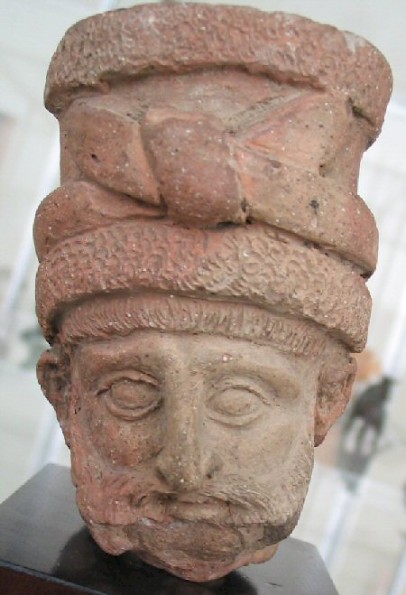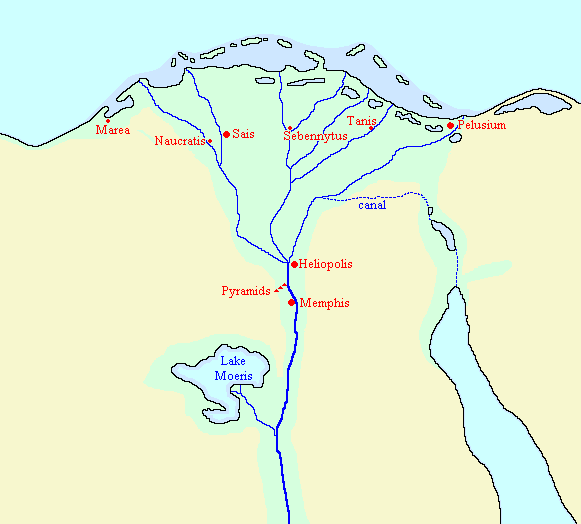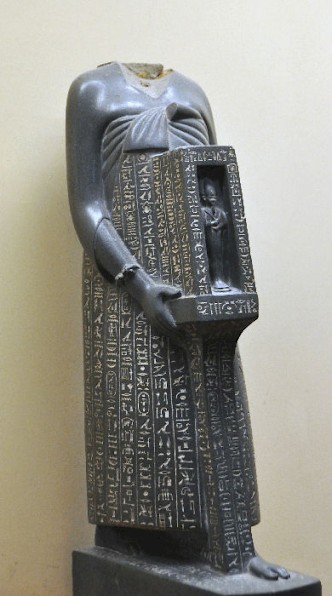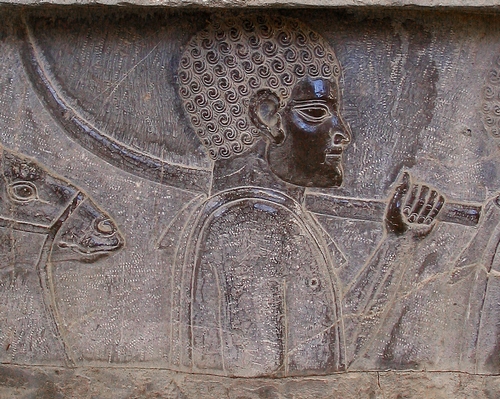Cambyses II
Cambyses: second king of the ancient Achaemenid Empire (ruled 530-522). In 525, he conquered Egypt.
Early career

Cambyses was the oldest son of Cyrus the Great, the first king of the Achaemenid empire (559-530). The Greek researcher Herodotus of Halicarnassus calls Cambyses' mother Cassandane, but Ctesias of Cnidus states she was Amytis, the daughter of the last king of independent Media, Astyages.
Cyrus' career had been dazzling. In 559, he became king of Persia; in 550, he subdued his overlord, Astyages the Mede. Three years later, he conducted operations west of the Tigris, and in 539, he added Babylonia to his empire.
Babylonia was an ancient kingdom, and its king played an important role in the religious and cultural life of the ancient Near East. If Cyrus were to rule Babylonia, he ought to act as a Babylonian king. In his official propaganda (the Cyrus Cylinder) he did indeed present himself as the one chosen by the Babylonian supreme god Marduk.
However, the great king was not in the position to be present when the Babylonians celebrated the Akitu festival. This was a problem, because the last king of independent Babylonia,Nabonidus, had lost much credit by not attending the festival for several years. To prevent similar troubles, Cyrus appointed his son Cambyses as king of Babylon, and in this quality, Cambyses was present during the ceremonies. A contemporary source, the Chronicle of Nabonidus, states:
When, on the fourth daynote Cambyses, son of Cyrus, went to the temple of ... the priest of Nabû who ... the bull ... They came and made the weaving by means of the handles and when he led the image of Nabû ... spears and leather quivers, from ... Nabû returned to Esagila, sheep offerings in front of Bêl and the god Mârbîti.
The lacunas in the text make it hard to understand what happened exactly, but it seems that there was an incident because Cambyses was incorrectly dressed: he and his men were armed, which was forbidden. Fortunately, the error was corrected and the statue of Nabû was brought to the Esagila temple according to the ritual regulations.
Succession
Cambyses' reign in Babylon lasted for only one year. It is not known why he resigned or what forced him to resign. The incident during the New Year's festival may have played a role. We simply do not know. It is possible that Cambyses was now made satrap of Bactria; in the next two generations, every crown prince served in that region. However, this is nothing but speculation.
According to Herodotus, Cyrus fell in a battle against the Massagetes in the last weeks of 530; the last cuneiform letter that is dated to his reign was written in November. Before the old king left, he had appointed Cambyses as his successor. The first letter dated to the reign of Cambyses was written on 31 August 530. So, there was a co-regency for some time, but by the end of the year, Cambyses was in charge of the empire his father had created.
Marriages
Every Persian king needed to secure the support of the nobility. One of the means to achieve this, was a dynastic marriage. Herodotus tells us that Cambyses married Phaedymia, the daughter of Otanes. This Otanes may have been the brother of Cassandane, who was (still according to Herodotus) Cambyses' mother. If Herodotus is right, Cambyses' queen was also his cousin. However, Herodotus makes at least one mistake in his description of the family tree (he calls Otanes' father Pharnaspes instead of Thukra), so we must be skeptical.
Two other marriages were concluded with his sisters. One of them was - according to Ctesias - called Roxane; the other was called Atossa and was later to marry Cambyses' successor Darius. Herodotus thinks that these marriages are an example of Cambyses' madness, but marriages like these were not uncommon in the world of ancient Zoroastrianism.
Death of Smerdis

The most important event during Cambyses' reign was the conquest of Egypt. This meant that the king was away from Persia for some time. The Histories of Herodotus, our most important source, and the Persian Behistun inscription agree that Cambyses ordered, as a kind of safety measure, Cambyses ordered his brother to be executed. Herodotus calls this brother Smerdis, the Behistun inscription calls him Bardiya, which is more or less the same name. The two sources disagree about the moment of the assassination: the Greek researcher dates it during the Egyptian campaign, the inscription states that it happened before Cambyses left Persia.
A son of Cyrus, named Cambyses, one of our dynasty, was king here [...]. That Cambyses had a brother, Smerdis by name, of the same mother and the same father as Cambyses. Afterwards, Cambyses slew this Smerdis. When Cambyses slew Smerdis, it was not known unto the people that Smerdis was slain. Thereupon Cambyses went to Egypt.
Probably, the inscription is correct. As we will see below, Herodotus has constructed a part of his Egyptian narrative as a catalogue of crimes and may well have postdated the fratricide.note
Conquest of Egypt
Egypt was prepared for war. Its pharaoh Amasis (Egyptian name Khnemibre Ahmose-si-Neit) had enlisted Carian and Greek mercenaries and had allied himself with Polycrates of Samos, who owned a large navy. This could be a great help, because marines could easily perform actions against the Persians when they were marching from Gaza to Pelusium, a vulnerable desert road along the coast. Shortly before the war broke out, Polycrates switched sides. Herodotus writes:
Without the knowledge of the Samians, Polycrates sent an envoy to Cambyses the son of Cyrus (who was gathering an army to attack Egypt) and asked him to send a messenger to him in Samos to ask for an armed force. When Cambyses heard this, he sent an envoy to the Samians and requested a naval force to join him in the war against Egypt. So Polycrates selected those of the citizens whom he most suspected of desiring to rise against him, and sent them away in forty warships, charging Cambyses not to send them back.note
It is not clear whether these people ever joined Cambyses' Phoenician navy, but in any case, Amasis could not count on their support.

We happen to possess the autobiography of the admiral of the Egyptian fleet, Wedjahor-Resne. It is written on a small statue now in the Vatican Museums in Rome. One element is curiously absent from this text: Wedjahor-Resne does not mention a naval battle. Herodotus does not mention fighting at sea either. It is possible that the Persians had bribed the Egyptian admiral and offered him an important function, because after the conquest, Wedjahor-Resne was Cambyses' right-hand man. Ctesias of Cnidus, who is not known for his reliability, explicitly mentions a traitor, although he calls him Combaphis.note
Amasis died during the preparations of the war, probably in November 526, and was succeeded by his son Psammetichus III (Ankhkaenre Psamtik). Six months later, the Persian invaders and their Arab allies reached Pelusium. The Egyptians were defeated and Cambyses' men continued to the Egyptian capital Memphis, which they took after a long siege. Psammetichus was captured alive and received a honorable treatment.
Pharaoh
Cambyses was recognized as the new pharaoh. Wedjahor-Resne tells:
The great king of all foreign countries Cambyses came to Egypt, taking the foreigners of every foreign country with him. When he had taken possession of the entire country, they settled themselves down therein, and he was made great sovereign of Egypt and great king of all foreign countries. His Majesty appointed me his chief physician and caused me to stay with him in my quality of companion and director of the palace, and ordered me to compose his titulary, his name as king of Upper and Lower Egypt, Mesuti-Ra [born of Re].

Stated differently, Wedjahor-Resne helped Cambyses behave like a true Egyptian king. (Cyrus had done his best to behave himself as a native king when he had conquered Babylon; his son followed his example in the ancient kingdom along the Nile.) For example, Wedjahor-Resne persuaded Cambyses to direct the Persian garrison in the holy city of Sais to another camp, making sure that the sanctuary of Neit, the mother of the supreme god Re, and the shrine of Osiris were purified. His autobiography also makes it clear that the conquest of Egypt was accompanied with great misery.
I am the benefactor of my city. I have saved its inhabitants from the very large troubles which had come over the whole country and which had not yet existed before in this country. I defended the meek against the powerful; I saved those who were afraid after an accident had happened to them; I gave them all useful things when they were unable to take care of themselves.
Human suffering must have been immense. Probably, every soldier in the Persian army was rewarded with an Egyptian slave. This can be illustrated with a contract from Babylon: on 31 December 524, the veteran soldier Idin-Nabû sold his Egyptian slave with her baby, who was three months old. (The conclusion that Idin-Nabû sold his own child seems inescapable.)note
Further Expeditions
Having conquered Lower Egypt, Cambyses sent out a small expeditionary force against the oases in the western desert. According to Herodotus, it reached the beautiful Bahariya oasis. But when the soldiers marched to Siwa, they were overtaken by the simoon storm and killed. The story was probably invented: in Herodotus' opinion, the deep south mirrored the high north - e.g., the Nile is symmetrical with the Danube - and the failed Persian expedition mirrors the 492 expedition of the Persians in the Aegean Sea.
Another expedition is more plausible: as any new pharaoh was supposed to do, Cambyses and a part of his army went to the south (524/523). The capital of Upper Egypt, Thebes, was occupied and the army continued along the Nile until it reached the first cataract, where a garrison was posted.note When Cambyses had reached the second cataract, he founded a town called "market of Cambyses". It may have been a fortified trading place where the Persians, Egyptians and Kushites (Nubian) could exchange commodities.
According to Herodotus, Cambyses intended to conquer Kush, but this is not very likely. Egypt was not completely pacified and it would have been foolish to leave the country before it was a safe possession of the Achaemenid empire. It is perhaps better to see the campaign to the border zone from an Egyptian point of view: the pharaoh had to go there at least once in his life to show himself as the true king.

A Persian embassy was sent to the Kushite capital, and the Kushites started to pay tribute (or continued an earlier trade). They are portrayed in Persepolis, bringing incense, ivory and an okapi for the great king's zoo.
Revolt in Egypt
Disquieting news forced Cambyses to return to Lower Egypt (Autumn 523). Psammetichus had organized a revolt against the new overlord. The Persian army could easily suppress the revolt, but its revenge was bloody and destructive. The Greek geographer Strabo of Amasia visited Thebes in 24 BCE and saw the ruins of several temples that had been destroyed. Perhaps this story was made up by the Egyptian priests, who had good reasons to hate Cambyses.
Pharaoh Amasis had offered great gifts to the temples, but Cambyses considered this outrageous. He may have tried to 'defend the meek against the powerful' by remitting the taxes that the Egyptians had to pay to the temples. A papyrus (now in the French Bibliothèque nationale) gives a summary of Cambyses' instructions:
Of the cattle that once were given by the people to the temples of the gods, let they give only half of it. [...] Regarding the poultry, do not give it to them any more. The priests are perfectly capable of rearing their own geese.
So the priests, who now had to breed their own geese, had good reason to hate the Persian king.